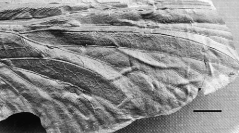

 Comptes Rendus Palevol
5 (7) - Pages 867-873
Comptes Rendus Palevol
5 (7) - Pages 867-873Un nouveau Palaeodictyoptera, Anglopterum magnificum gen. et sp. n., est décrit de concrétions du Carbonifère supérieur (Langsettien) du Lancashire (Angleterre). Ce nouveau genre, basé sur la nervation de l'aile postérieure, est attribué aux Homoiopteridae et comparé avec d'autres genres de cette famille. Un Homoiopteridae figuré auparavant du Carbonifère supérieur (Asturien supérieur) du Somerset a un champ anal similaire à celui de Mazonopterum wolfforum Kukalová-Peck et Richardson, 1983. Ce sont les premières espèces décrites d'Homoiopteridae des îles Britanniques. De plus, leur nervation, similaire à celle de Mazonopterum wolfforum Kukalová-Peck et Richardson, 1983 du Mazon Creek (États-Unis), apporte des indices supplémentaires en faveur d'une connexion euro-américaine au Carbonifère supérieur.
A new palaeodictyopteran, Anglopterum magnificum gen. et sp. n., is described from concretions of Late Carboniferous (Langsettian) in the Lancashire County (UK). The new genus, based on the hind-wing venation, is attributed to Homoiopteridae and compared with other homoiopterid genera. A previously figured homoiopterid from Late Carboniferous (Upper Asturian) roof shales in Somerset (UK) is bearing venation pattern of anal area similar to Mazonopterum wolfforum Kukalová-Peck and Richardson, 1983. These are the first formally described species of Homoiopteridae from the British Isles. Furthermore, their similarity in venation pattern to Mazonopterum wolfforum Kukalová-Peck and Richardson, 1983 from Mazon Creek (USA) provides evidence for a Euramerican connection during the Late Carboniferous. .